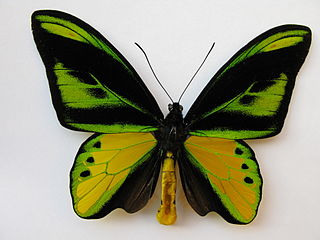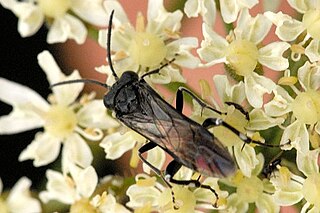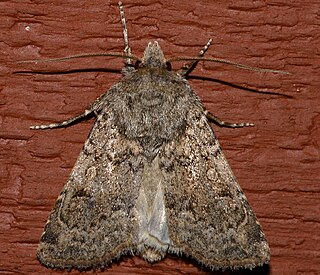
A pupa is the life stage of some insects undergoing transformation between immature and mature stages. Insects that go through a pupal stage are holometabolous: they go through four distinct stages in their life cycle, the stages thereof being egg, larva, pupa, and imago. The processes of entering and completing the pupal stage are controlled by the insect's hormones, especially juvenile hormone, prothoracicotropic hormone, and ecdysone. The act of becoming a pupa is called pupation, and the act of emerging from the pupal case is called eclosion or emergence.

Sawflies are wasp-like insects that are in the suborder Symphyta within the order Hymenoptera, alongside ants, bees, and wasps. The common name comes from the saw-like appearance of the ovipositor, which the females use to cut into the plants where they lay their eggs. The name is associated especially with the Tenthredinoidea, by far the largest superfamily in the suborder, with about 7,000 known species; in the entire suborder, there are 8,000 described species in more than 800 genera. Symphyta is paraphyletic, consisting of several basal groups within the order Hymenoptera, each one rooted inside the previous group, ending with the Apocrita which are not sawflies.

Ornithoptera alexandrae, the Queen Alexandra's birdwing, is the largest species of butterfly in the world, with females reaching wingspans slightly in excess of 25 cm to 28 cm. This birdwing is restricted to the forests of the Oro Province in eastern Papua New Guinea.

Troides minos, the southern birdwing, also called Sahyadri birdwing, is a large and striking swallowtail butterfly endemic to South India. With a wingspan of 140–190 mm, it is the second largest butterfly of India. It is listed as Least Concern in the IUCN Red List.

Tenthredinidae is the largest family of sawflies, with well over 7,500 species worldwide, divided into 430 genera. Larvae are herbivores and typically feed on the foliage of trees and shrubs, with occasional exceptions that are leaf miners, stem borers, or gall makers. The larvae of externally feeding species resemble small caterpillars. As with all hymenopterans, common sawflies undergo complete metamorphosis.

Leathesia marina (Lyngbye) Decaisne, 1842, previously known as Leathesia difformis Areschoug, 1847, commonly known as the sea cauliflower the sea potato, and brown brains is a species of littoral brown algae in the class Phaeophyceae and the order Ectocarpales, which is commonly attached to other seaweeds and sometimes rocks. When young, the organism is solid but as it matures it becomes hollow and somewhat convoluted and has the appearance of a small leathery brown bag about the same size as a tennis ball. The texture is rubbery and the outer surface smooth.

Ornithoptera chimaera, the chimaera birdwing, is a birdwing butterfly of the family Papilionidae. It is found in mountain areas of New Guinea, 1000 meters above sea level.

Ornithoptera paradisea, the paradise birdwing, is a species of birdwing butterfly found in New Guinea.

Nematinae is a subfamily of sawflies belonging to the family Tenthredinidae. It contains over 1250 described species in ~40 genera. Members of this subfamily feed on a wide range of plants and employ a wide range of feeding habits, both internally and externally, on their host plants.

Allantinae is a subfamily of sawflies in the family Tenthredinidae, and the largest subfamily of that family, with about 110 genera. The subfamily is considered to consist of five to six tribes, and are medium to large sawflies.

Eriocampa ovata, known generally as the alder sawfly or woolly alder sawfly, is a species of common sawfly in the family Tenthredinidae. The larvae feed on the leaves of the common alder and the grey alder, sometimes causing defoliation.

Eriocampa is a genus of common sawflies in the family Tenthredinidae. There are about ten described species in Eriocampa.

Monophadnoides rubi, the raspberry sawfly, is a species of common sawfly in the family Tenthredinidae.

Monophadnoides is a genus of common sawflies in the family Tenthredinidae. There are about eight described species in Monophadnoides.

Monsoma pulveratum, the green alder sawfly, is a species of common sawfly in the family Tenthredinidae. It is a European species that has been accidentally introduced in North America.

Monsoma is a genus of common sawflies in the family Tenthredinidae. There are at least two described species in Monsoma.
Ericthonius is a genus of amphipods in the family Ischyroceridae. There are at least 20 described species in Ericthonius.

Euxoa difformis is a cutworm or dart moth in the family Noctuidae. The species was first described by Smith in 1900. It is found in North America.

Cladius is a genus of common sawflies in the family Tenthredinidae. There are about 17 described species in Cladius.





















